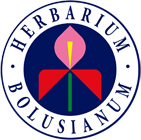Present herbarium holdings
The present herbarium contains approximately a third of a million specimens, housed in modern premises in steel cabinets in the Pearson Building, Biological Sciences, UCT. It is the third largest herbarium in South Africa and one of the largest university herbaria in the southern hemisphere. With over 11,500 Type specimens, especially of the Cape Flora, the Bolus Herbarium houses a disproportionate number for its collection size. While the herbarium is well curated, only half of the collection is computer databased (see list under heading Databasing). A specialist herbarium of the Cape Peninsula has been developed for use as a teaching and a quick identification guide. Especially important collections are:
| Taxon | Major collector(s) |
|---|---|
|
Algae |
Tyson, Becker, Stevens, Stegenga, Bolton |
|
Lichens |
Garside, Schelpe, Almborn |
|
Mosses |
Pillans, Esterhuysen, Schelpe, Hedderson |
|
Ferns |
Schelpe |
|
Poaceae |
Linder, Verboom |
|
Cyperaceae |
Muasya |
|
Restionaceae |
Esterhuysen, Linder |
|
Orchidaceae |
Bolus, Schlechter, Schelpe, Hall, Linder |
|
Proteaceae |
Williams |
|
Aizoaceae |
L. Bolus, Klak |
|
Rutaceae |
Williams, Bean |
|
Oxalidaceae |
Salter |
|
Ericaceae |
Bolus, Guthrie, Esterhuysen |
|
Apocynaceae |
Pillans, Bruyns |
|
Aspalathus (Fabaceae) |
Dahlgren, Stirton |
|
Psoralea & Otholobium (Fabaceae) |
Stirton |
|
Muraltia (Polygalaceae) |
Levyns |
|
Jamesbrittenia (Scrophulariaceae) |
Verboom |
|
Western Cape High Mountain Flora |
Esterhuysen |
|
Southern Cape Flora |
Fourcade |
Databasing
Databasing takes place on an ad hoc basis. As taxa are revised by staff and students, all the material in the collection pertaining to the taxon in question is databased. Furthermore, all material that has been requested as a loan, since 1995, has been databased prior to being dispatched and all newly accessioned material, since 2005, is databased prior to being laid into the cupboards.
The following taxa have been databased in their entirety:
Aizoaceae, Amaryllidaceae, Cyperaceae, Fabaceae, Geraniaceae, Portulacaceae, Potamogetonaceae, Proteaceae, Restionaceae, Rutaceae, Orchidaceae, Afrosciadium (Apiaceae), Cliffortia (Rosaceae), Centella (Araliaceae), Conium (Apiaceae), Crassula (Crassulaceae), Erhartha (Poaceae), Harveya (Orobanchaceae), Heliophila (Brassicaceae), Hermannia (Sterculiaceae), Lachenalia (Hyacynthaceae), Lobelia (Lobeliaceae), Micranthus (Iridaceae), Nanobubon (Apiaceae), Notobubon (Apiaceae), Massonia (Hyacynthaceae), Moraea (Iridaceae), Pentameris section Pentaschistis (Poaceae), Roepera (Zygophyllaceae), Romulea (Iridaceae), Silene (Caryophyllaceae), Thesium (Santalaceae), Tribolium (Poaceae).
The Asteraceae have been databased in part, with the following genera having been completed:
Achyrocline, Amellus, Anaxeton, Anderbergia, Arctotheca, Arctotis, Aster, Atricantha, Berkheya, Bothriocline, Brachycome, Calotesta, Cassinia, Chrysocoma, Conyza, Cullumia, Cuspidia, Didelta, Dolichothrix, Dymondia, Edmondia, Erigeron, Erlangea, Ethulia, Felicia, Galeomma, Gazania, Gnaphalium, Gorteria, Gutenbergia, Gymnostephium, Haplocarpha, Helichrysum, Heterorachis, Hirpicium, Humea, Lachnospermum, Langebergia, Lasiopogon, Mairia, Metalasia, Nidorella, Nollettia, Olearea, Petalacte, Phagnalon, Platycarpha, Plecostachys, Poecilolepis, Polyarrhena, Pteronia, Senecio, Syncarpha, Tenrhynea, Troglophyton, Vellereophyton , Zoutpansbergia, Zyrphelis.
Take note that these data are not accessible through internet. Records for the families Cyperaceae and Aizoaceae are however searchable on the following link: http://www.sabif.ac.za
Scanned images for all of the 11,500 Types housed at BOL (these exclude Bryophytes and Hepatics) can be viewed by staff/students from institutions subscribed to using the facilities provided by JSTOR at http://plants.jstor.org/
